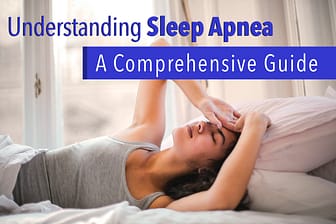 Sleep apnea is a common yet often misunderstood sleep disorder that affects millions of people worldwide. It’s characterized by interruptions in breathing during sleep, leading to disrupted rest, health concerns, and a reduced quality of life. In this comprehensive guide, we’ll delve into the various aspects of sleep apnea, from its types and symptoms to diagnosis and treatment options, shedding light on a condition that many individuals may not even be aware they have.
Sleep apnea is a common yet often misunderstood sleep disorder that affects millions of people worldwide. It’s characterized by interruptions in breathing during sleep, leading to disrupted rest, health concerns, and a reduced quality of life. In this comprehensive guide, we’ll delve into the various aspects of sleep apnea, from its types and symptoms to diagnosis and treatment options, shedding light on a condition that many individuals may not even be aware they have.
What is Sleep Apnea?
Sleep apnea is a disorder in which a person’s breathing repeatedly stops and starts during sleep. These interruptions in breathing, known as apneas, can last for seconds to minutes and may occur multiple times throughout the night. Let’s explore each type in more detail:
- Obstructive Sleep Apnea (OSA): This is the most prevalent form of sleep apnea. It occurs when the throat muscles relax excessively during sleep, leading to a blockage or obstruction of the airway. This obstruction causes snoring and disrupted sleep patterns, often leading to daytime fatigue and other health issues.
- Central Sleep Apnea (CSA): CSA is less common and differs from OSA in that it’s not related to a physical blockage of the airway. Instead, it’s a result of a communication breakdown between the brain and the respiratory muscles. Individuals with CSA may experience episodes of not breathing without snoring.
- Complex or Mixed Sleep Apnea: In some cases, individuals may exhibit a combination of both OSA and CSA, referred to as complex or mixed sleep apnea. This condition requires specialized evaluation and treatment strategies.
Recognizing the Symptoms
Sleep apnea often goes undiagnosed because the person experiencing it is asleep during the episodes. However, some common signs and symptoms may include:
- Loud and persistent snoring: While not everyone who snores has sleep apnea, it’s a common symptom, especially in OSA.
- Gasping or choking during sleep: This can be alarming and disruptive to sleep, often affecting the bed partner’s sleep as well.
- Excessive daytime sleepiness: Due to disrupted sleep, individuals with sleep apnea often struggle with excessive daytime fatigue, which can affect daily activities.
- Morning headaches: Frequent awakenings and oxygen desaturation can lead to morning headaches.
- Difficulty concentrating: Cognitive issues, memory problems, and difficulty focusing are common complaints among those with untreated sleep apnea.
- Irritability and mood changes: Sleep deprivation can lead to irritability, mood swings, and even depression in some cases.
- Frequent nighttime awakenings: Individuals with sleep apnea may wake up multiple times during the night, often without remembering these awakenings.
Diagnosis and Assessment
Proper diagnosis is crucial for effective management. Physicians often use various diagnostic tools, including sleep studies (polysomnography), to monitor a person’s sleep patterns and detect sleep apnea. These studies track important parameters such as airflow, oxygen levels, brain activity, and more.During a sleep study, a person is monitored while sleeping in a controlled environment, allowing healthcare providers to evaluate the severity and type of sleep apnea. Home sleep tests are also available in some cases for diagnosing mild to moderate sleep apnea.
Treatment Options
Fortunately, several treatment options are available for managing sleep apnea and improving sleep quality. These may include:
- Lifestyle Changes: Adopting healthier habits such as weight loss, regular exercise, and avoiding alcohol and sedatives can help reduce the severity of sleep apnea. Weight loss, in particular, can significantly improve symptoms, especially in cases of OSA.
- Continuous Positive Airway Pressure (CPAP): A CPAP machine delivers a continuous stream of air to keep the airway open during sleep, preventing apneas. CPAP is a highly effective treatment for OSA and is often considered the gold standard.
- Oral Appliances: These are dental devices that help reposition the jaw and tongue to keep the airway open. They are commonly used for individuals who cannot tolerate CPAP or have mild to moderate OSA.
- Surgery: In some cases, surgical interventions may be recommended to remove excess tissue or correct structural issues in the airway. Surgery is typically considered when other treatments have failed or in severe cases of OSA.
Living with Sleep Apnea
Living with sleep apnea can be challenging, but with proper treatment and lifestyle adjustments, individuals can significantly improve their sleep quality and overall well-being. It’s essential for those with sleep apnea to:
- Adhere to Treatment: Consistently use prescribed treatments, such as CPAP or oral appliances, to manage the condition effectively.
- Maintain a Healthy Lifestyle: Weight management, regular exercise, and avoiding smoking and excessive alcohol consumption can help alleviate symptoms.
- Regular Follow-Up: Regularly follow up with healthcare providers to monitor progress and adjust treatment plans as needed.
- Raise Awareness: Educate friends and family about sleep apnea to create a supportive environment.
Throughout this guide, we’ll explore each aspect of sleep apnea in more detail, providing valuable insights and practical advice to help those affected by this condition lead healthier, more restful lives. Stay tuned for further sections that delve deeper into these topics.
